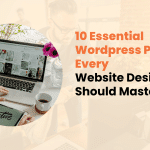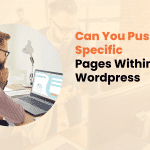In today’s digital landscape, a well-designed website is crucial for any business or individual aiming to establish a strong online presence.
Your website often serves as the first point of contact between you and potential customers, making it essential to create a positive and lasting impression.
However, designing an effective website involves much more than just aesthetics. This article explores ten critical factors you should consider when designing a website to ensure it looks great, performs well, and meets your business objectives.
1. User Experience (UX) and User Interface (UI)
At the heart of any successful website lies an exceptional user experience. Your website should be intuitive, easy to navigate, and enjoyable.
When focusing on UX and UI, consider creating a clear and logical menu structure that guides visitors through your site. Use descriptive labels for navigation items and implement a search function for larger sites to help users quickly find what they’re looking for.
Responsive design is another crucial aspect of UX/UI. Use flexible layouts and images to ensure your website adapts seamlessly to different screen sizes. Implement touch-friendly elements for mobile users to improve their experience on smaller devices.
Consistency in design elements is key to creating a cohesive user experience. Maintain a uniform color scheme throughout the site, use consistent typography and button styles, and keep layout structures similar across different pages. This consistency helps users feel comfortable and familiar as they navigate your site.
Remember, a great UX/UI design can significantly reduce bounce rates and increase conversions, ultimately contributing to your website’s success.

2. Website Speed and Performance
In our fast-paced digital world, users expect websites to load quickly. Slow-loading sites can lead to high bounce rates and poor user engagement. Moreover, page speed is a ranking factor for search engines, making it crucial for SEO.
To improve your website’s speed and performance, consider the following:
- Optimize image sizes and formats
- Minify CSS, JavaScript, and HTML
- Use browser caching effectively
- Implement a Content Delivery Network (CDN) to distribute your content globally
Research shows that 47% of users expect a web page to load in 2 seconds or less, and 40% will abandon a website that takes more than 3 seconds to load. A 1-second delay in page response can result in a 7% reduction in conversions. These statistics highlight the importance of regularly testing your website’s speed using tools like Google PageSpeed Insights or GTmetrix and making necessary improvements to ensure optimal performance.

3. Mobile Responsiveness
With mobile devices accounting for over 50% of global web traffic, mobile responsiveness is no longer optional – it’s essential. Google’s mobile-first indexing means that the mobile version of your website is considered the primary version for ranking purposes.
When designing for mobile devices, adopt a mobile-first approach. This means designing for smaller screens first and then scaling up for larger displays. Use responsive images that adjust to screen sizes and implement touch-friendly navigation and buttons.
Also, optimize forms for mobile input to provide a smooth user experience on smartphones and tablets.
Mobile-friendly websites tend to rank higher in mobile search results. They also provide a better user experience, which can lead to longer visit durations and lower bounce rates. A well-designed mobile experience can increase conversions and help you reach a wider audience.

4. Content Strategy
Content is the backbone of your website. It draws visitors in, keeps them engaged, and ultimately converts them into customers. A well-planned content strategy is crucial for both user engagement and SEO.
When creating content for your website, focus on:
- Quality and relevance
- Produce original, valuable content that addresses your audience’s needs
- Use a mix of content types (text, images, videos, infographics)
- Keep your content up-to-date and accurate
- Content structure and hierarchy
- Use clear headings and subheadings (H1, H2, H3, etc.)
- Break up text with bullet points and short paragraphs
- Include a table of contents for longer articles
- SEO-friendly practices
- Conduct keyword research and use relevant keywords naturally
- Optimize meta titles and descriptions
- Use internal linking to connect related content
- Include alt text for images
Remember, your content should appeal to search engines and provide genuine value to your readers. Strive to create informative, engaging, and shareable content that establishes your expertise in your field.

5. Visual Design and Branding
The visual aspect of your website plays a crucial role in capturing and retaining user attention. It should reflect your brand identity and create a memorable experience for visitors. When designing your website, pay attention to your color scheme and typography. Choose colors that align with your brand and evoke the right emotions. Select fonts that are easily readable and complement your overall design.
High-quality, relevant images and videos can enhance your website’s visual appeal. However, to maintain good performance, optimize these media files for quick loading. Consider using custom graphics or illustrations to make your site stand out from competitors.
Brand consistency is key to creating a strong online presence. Prominently display your logo and use consistent brand messaging and tone of voice throughout your site. Ensure your website design aligns with your other marketing materials to create a cohesive brand experience across all channels.

6. Accessibility
Designing an accessible website ensures all users, including those with disabilities, can access and interact with your content. It’s a legal requirement in many jurisdictions and expands your potential audience.
Key accessibility considerations include:
- Providing alternative text for images
- Ensuring sufficient color contrast
- Making your website keyboard-navigable
- Using descriptive link text
- Providing captions and transcripts for multimedia content
Follow the Web Content Accessibility Guidelines (WCAG) 2.1, aiming for AA-level compliance. Implementing accessibility features benefits all users and can improve your website’s overall usability and SEO performance.
7. Search Engine Optimization (SEO)
While creating a website for users is paramount, optimizing it for search engines is equally important to ensure it reaches your target audience. Focus on on-page and technical SEO elements to improve your website’s visibility in search results.
On-page SEO involves optimizing individual web pages to rank higher and earn more relevant traffic. This includes optimizing title tags and meta descriptions, using header tags effectively, creating SEO-friendly URLs, and optimizing images with alt text and descriptive file names.
Technical SEO refers to optimizing the infrastructure of your website. Implement a logical site structure, create and submit an XML sitemap, use schema markup to help search engines understand your content, and ensure your website is mobile-friendly and fast-loading.
For local businesses, remember local SEO. Claim and optimize your Google My Business listing, ensure NAP (Name, Address, Phone) consistency across the web, and encourage and respond to customer reviews.
Remember, SEO is an ongoing process. Regularly review and update your SEO strategy to maintain and improve your search engine rankings.

8. Security and Privacy
In an era of increasing cyber threats and data breaches, ensuring your website’s security and protecting user privacy is crucial. Install an SSL certificate to encrypt data transmission and implement HTTPS across your website. Redirect all HTTP traffic to HTTPS to ensure secure connections.
Implement strong data protection measures:
- Use strong, unique passwords for all accounts
- Enable two-factor authentication where possible
- Keep your content management system and plugins up-to-date
- Perform regular backups of your website
Compliance with privacy regulations is also essential. Familiarize yourself with relevant privacy laws such as GDPR or CCPA. Create and display a clear privacy policy on your website. Implement necessary consent mechanisms for data collection and provide users with control over their data.
A secure website protects your business and users and builds trust and credibility, which can lead to increased customer loyalty and conversions.
9. Scalability and Future-Proofing
As your business grows, your website should be able to grow with it. Designing with scalability in mind can save you time and resources in the long run. Start by choosing the Content Management System (CMS) that can handle your current and future needs. When deciding, consider factors like ease of use, customization options, and community support.
When planning for future growth, design a flexible information architecture that can accommodate new pages and sections as your content expands. Use modular design principles for easy updates and additions. Also, plan for increased traffic and data storage needs as your audience grows.
When designing your website, consider your future integration needs. Choose platforms and tools that offer robust APIs, allowing you to integrate new features and functionalities as your business evolves. This might include e-commerce capabilities, marketing automation tools, or customer relationship management systems.
By planning for the future, you can create a website that evolves with your business and maintains its effectiveness over time.

Conclusion
Designing a website involves much more than creating an attractive layout. By considering these ten essential factors – user experience, performance, mobile responsiveness, content strategy, visual design, accessibility, SEO, security, and scalability –you can create a website that not only looks great but also performs well, ranks high in search engines, and effectively serves your business goals.






